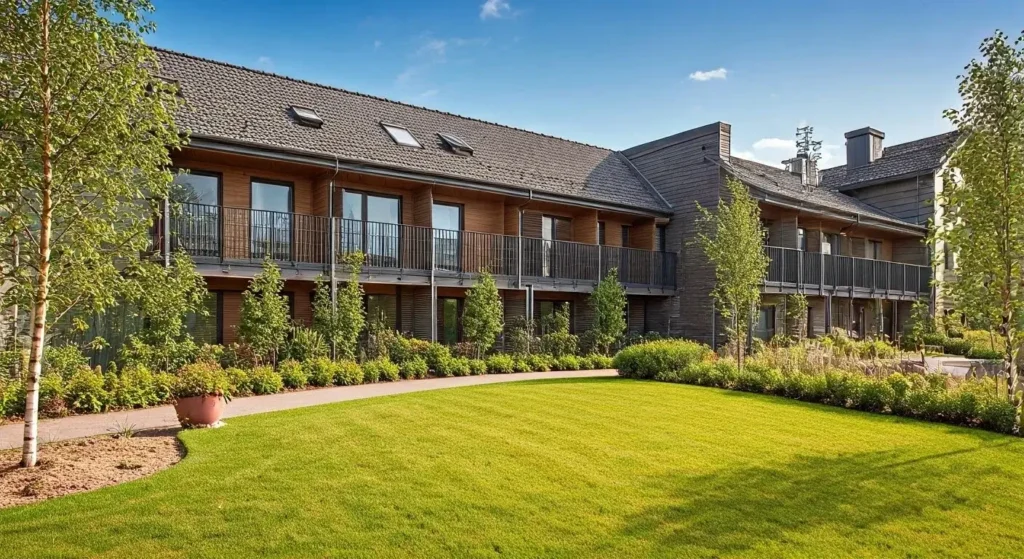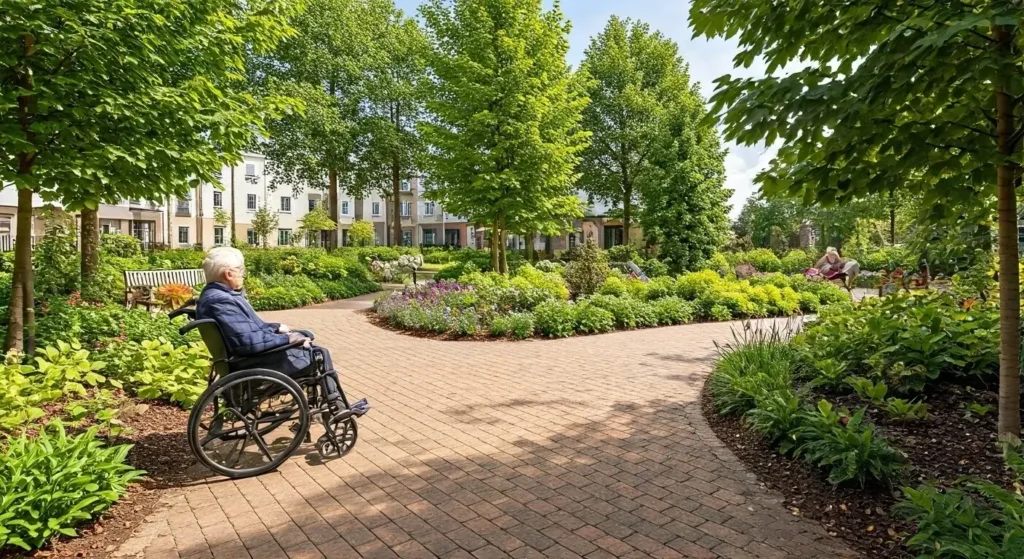Best Retirement Village Architect: Design Your Dream Home
Key Highlights
- Retirement home design should prioritize residents’ health and well-being.
- Thoughtful design can improve mobility, social interaction, and access to nature.
- Incorporating natural lighting, ventilation, and calming design elements is crucial.
- Wellness-focused amenities and technology can enhance residents’ quality of life.
- Safety, accessibility, and ergonomic design are paramount in aged care facilities.
- Experienced aged care architects can create supportive and vibrant communities.

In today’s world, the idea of retirement living, including pavilions, is changing a lot. It’s very important to focus on the health and happiness of seniors. This means we should look beyond just their basic needs and consider the latest trends in design. The design of the building, such as pavilions, is also very important. A good retirement home should help residents feel better both physically and mentally. It should also support their social life, creating a happy and fulfilling place to live. Enhance your understanding by reading our in-depth post on Efficient Ecommerce Order Fulfilment Companies for Growth.
Strategies for Incorporating Health and Wellness in Retirement Home Design

Designing retirement homes for health and wellness takes a full-picture approach, including effective project management in aged care design. This means focusing on different parts, like encouraging physical activity, fostering social connections, giving access to nature, and prioritizing mental health. It’s also important to include safety, easy access, and designs that are simple to use. Best retirement village architects know how to blend these elements thoughtfully to create supportive spaces. Architects who specialize in aged care understand the unique needs of seniors and how to build environments that promote well-being.
When we understand what seniors need, a well-planned retirement home can improve their quality of life. Here are some key strategies to reach this goal:
Designing with Mobility in Mind
One big concern in aged care facilities is how easily residents can move around. It is important to have wide hallways, non-slip floors, handrails in the right spots. Functionality is important. Doorways should be wide enough for wheelchairs and walkers. Bathrooms should have grab bars and fixtures that can be adjusted.
It is also good to think about where amenities and common areas are placed. This helps reduce how far residents have to walk. Designing for mobility keeps people safe. It also helps them feel more independent and encourages them to stay active. Find valuable tips and strategies in our article about Strengthen Your Business Foundation with Assurance Advisory.
Integrating Nature and Outdoor Spaces
The benefits of nature on wellness are clear. Having outdoor spaces is not just nice to look at; it is important for people’s health. Residents need easy access to gardens, courtyards, or walking paths. These areas allow for relaxation, meeting others, and connecting with nature. This connection helps their mental and emotional health a lot.
Bringing nature indoors matters just as much. Big windows and skylights can let in natural light and show views of the outside. Adding indoor plants and water features can create a calm and refreshing feel in the space.
Natural Lighting and Ventilation
Natural lighting and ventilation are not just aspects of design; they are important for making healthy homes. Getting more natural light in dining rooms, living areas, and bedrooms can boost mood, help with sleep patterns, and lower the need for artificial lights. You can do this by using big windows, skylights, and open layouts.
Good ventilation is also very important. It helps keep the air clean and prevents breathing problems, which can matter a lot for older people. Designing buildings to use natural airflow and adding systems for mechanical ventilation makes sure there is always fresh air. This leads to a healthier living space.
Inclusive, Multi-Functional Spaces
In retirement living, it is very important to create spaces that meet different needs and abilities. Using inclusive design makes sure that shared areas, activity rooms, and outdoor spaces are easy for all residents to use, no matter their physical limits. Having multi-functional spaces improves life in the community even more. Shared areas can be changed for many activities, like fitness classes, movie nights, social events, and educational workshops.
This flexibility not only makes better use of the space but also builds a sense of community. It helps residents connect and interact with each other more.
Promoting Social Interaction
Social interaction is very important for helping older people avoid feeling alone and for supporting their mental health. The way a building is designed can greatly affect how people interact. Open layouts, well-placed seating, and shared dining areas can invite residents to talk and form connections.
Community kitchens, game rooms, libraries, and cinemas work well as places where residents meet, tell stories, and do activities together. Comfortable furniture, warm lights, and friendly decor can make these social areas even better. This helps to create a strong sense of community. Read another trending article, Mastering Stability.
Calming and Therapeutic Design Elements
Retirement homes need to have a calm and comfy place for residents. This helps them relax and feel less stressed. Using special design ideas in aged care can help how residents feel.
Soft colors, natural materials, and gentle textures can make a big difference. Adding things like indoor gardens, fish tanks, or water features can bring a sense of calm. Also, reducing noise from traffic or machines can help create a peaceful setting.
Incorporating Fitness and Movement Areas
Maintaining good physical health is important for everyone’s well-being, especially as they get older. When retirement homes have special fitness and movement areas, it helps residents to stay active. These areas can include fitness centers with the right equipment for older adults, yoga studios, and swimming pools. Simple features, like walking tracks and exercise rooms, can also help encourage people to be active.
These spaces do more than improve physical health. They also offer chances for socializing and help create a sense of community.
Safe and Ergonomic Furniture
Furniture in aged care facilities is very important for safety and comfort. Chairs and sofas need to support the back well. The seat heights should allow residents to sit and stand easily. Ergonomic designs, like adjustable beds and chairs, can make residents more comfortable and reduce injury risks.
Safety must come first. Using non-slip surfaces, having rounded edges on furniture, and installing grab bars in key places can help stop accidents and keep residents safe.
Wellness-Focused Amenities
Modern retirement homes are adding more than just living spaces. They now include great amenities that focus on the dedication to the well-being of residents. These features aim to improve the quality of life and support a complete approach to senior living.
For example, wellness centers may offer services like massage therapy, aromatherapy, and relaxation techniques. These can help reduce stress. On-site salons and barber shops can lift spirits and self-esteem.
Communal libraries and computer rooms create chances for mental exercise and social interaction. The main goal is to provide different options that meet the physical, emotional, and social needs of residents. This helps to enhance their overall well-being.
Technology for Health Monitoring
Integrating technology in aged care facilities can change how we monitor health and provide care. Smart sensors can be placed in apartments. They will quietly watch residents’ movements and vital signs. If there is an emergency or a change in health, staff will be alerted via email. Telehealth services make it easy to have virtual visits with doctors. This cuts down on travel and allows for quick medical help.
Also, wearable technology can help residents keep track of their health data. This gives them control over their health and encourages them to take charge of their wellness.
Conclusion
In conclusion, it is important to design retirement homes that focus on health and wellness. This helps residents feel better overall. Features like easy-to-move spaces, access to nature, plenty of natural light, and places for exercise can improve life for older people. Building a sense of community through social interactions is also important. Adding calming design elements helps create a positive living space. By using technology for health tracking and offering wellness amenities, retirement homes can meet the healthcare needs of their residents. Using safe and comfortable furniture makes life easier and safer. This supports a complete approach to health and wellness in retirement home design. You can visit Fintechzoom.com for more trending posts.




